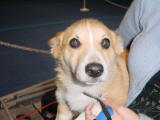Introduction
to the Concept of "Correction"
The goal is to have the dog
realize he made a mistake and,
therefore, not repeat the
unwanted behavior.
Some individuals or breeds are
described as "sensitive."
Most Shetland Sheepdogs
(Shelties) fall into this category.
Simply being ignored is a severe
correction to a Sheltie.
On
the other hand, some dogs do
not seem to notice a strong
collar jerk.
When in fact,
they do notice it, they just
don't know how to respond to
avoid it. When this is the
case, it is usually because
the training of basic manners
was not implemented early enough
in life.
This is when it becomes
necessary to begin remedial
training to teach the dog how to
respond correctly to a basic
vocabulary.
The
right type of correction
results in the dog stopping
behaviors you disapprove of and
learning what behaviors are
acceptable.
 The
appropriate level of
correction is determined by the
dog's behavior. If your dog
responds quickly
as desired, the level is
appropriate.
Corrections only interrupt
the unwanted behavior and do not
teach the dog not to repeat that
behavior in the future.
Teach the dog an alternative
behavior to replace the unwanted
one.
The
appropriate level of
correction is determined by the
dog's behavior. If your dog
responds quickly
as desired, the level is
appropriate.
Corrections only interrupt
the unwanted behavior and do not
teach the dog not to repeat that
behavior in the future.
Teach the dog an alternative
behavior to replace the unwanted
one.
If
the dog responds with a fearful
cower of ears, tail, and
eyes down, head turning away
from you, then your correction
needs to lighten up. If the dog
rolls over or urinates, then you
correction was too harsh and
your dog is feeling threatened
by you.
If a dog
shows any sign of being
sorry, you
went to far and must
immediately stop the correction.
Continuing a correction after a
dog "gives" is bullying the dog. If the dog is
already in this posture and
you (the teacher and leader)
continue to correct or punish
him, it is normal dog behavior
to either flee from you or fight (become aggressive).
|
The
joy of a relationship is
love. Therefore, we must be
careful not to damage the
relationship. This can be
done by doing too little
guidance and unclear
training and from
inappropriate corrections. |
Start with the Lowest Level
Correction Possible
Non-Physical and Non-Verbal
Corrections
Level One:
The
lowest level of correction is
withholding a desired
reward. This might
mean withholding attention (ignoring
the dog), withholding praise
and affection or delaying food
or a greeting.
Level Two:
The next level is a postural
correction. This might
be leaning over
the dog coupled
with a stern look. Some dogs are
more responsive to this than
others. The
postural correction may or may
not be coupled with a verbal
correction.
Level Three:
The
next level up is physical separation,
or "owner out of sight." This is
also called
a "time out."
This could mean putting the
dog outside or in another room
or keeping him tethered for 10
to 20 minutes on a short lead.
The effect is to remove the
dog's freedom of movement.
If a dog is immediately and
consistently put in a "time out"
after unwanted behavior, he will
learn quickly to associate that
unwanted behavior with the "time
out" loss of freedom and social
contact - both important to
dogs.
If the dog is aggressive in any
way at any time, it is important
to begin remedial training and
consult with a veterinary
behaviorist. Ask your
veterinarian to help you fit a
head collar to wear all the time
connected to a long lead. Use
the lead to move the dog into
time out.
If you fear your dog may bite,
have your veterinarian fit a
basket muzzle (cookie mask)
until you see a consistent
relaxed muscle tone in your dogs
body language with no sign of
lunging to bite defensively or
offensively. Aggressive postures
include a stiff (frozen) stance,
ears pricked, hair bristled,
pupils wide, leaning forward and
a crinkled muzzle. You may or
may not see the dog's teeth.
Go to
Page 2 - Verbal Corrections
|
It is important to earn the
dog's respect with clear,
consistent instruction and
praise before implementing
corrections. |